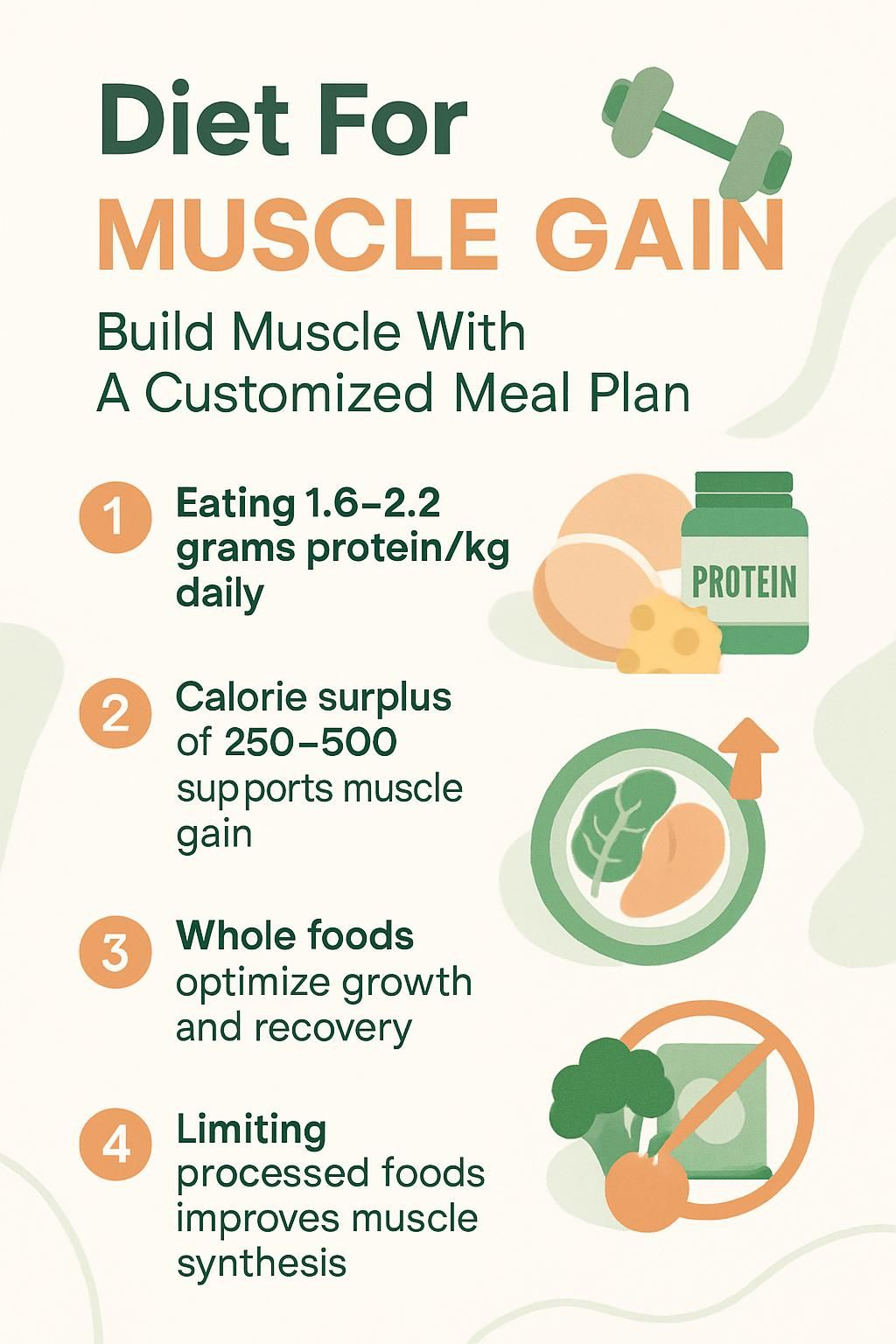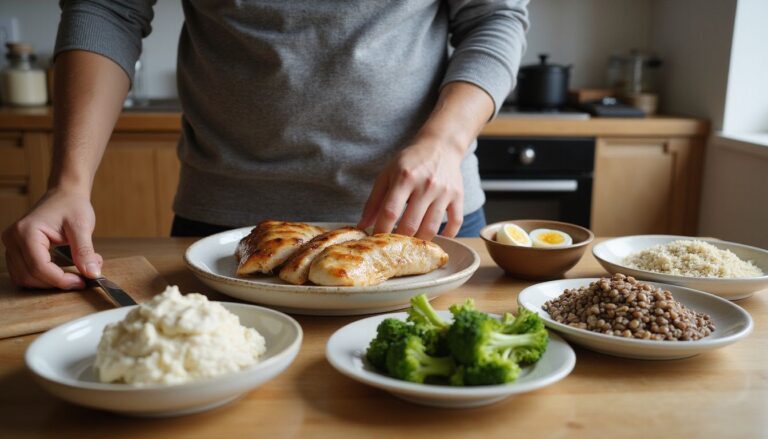Diet For Muscle Gain: Build Muscle With A Customized Meal Plan
Our Nutrition Assistant AI Suite will transform your body. You will lose fat, get toned, and build muscle. Gain confidence and optimal health.
If you are trying to build muscle but feel unsure about what to eat, you are not alone. A solid plan that covers dietary protein, calories, and key nutrients makes muscle gain faster and more predictable.
This guide shows how a customized meal plan helps you gain more muscle, improve strength, and reach goals sooner. You will see which foods support lean mass and which ones slow progress.
Key Takeaways
- Aim for 1.6 to 2.2 grams of protein per kilogram of body weight each day, paired with resistance training, to build lean muscle effectively (Phillips et al., 2016).
- A calorie surplus of 250 to 500 calories above maintenance supports steady muscle gain while limiting body fat.
- Base your meals on whole foods: quality protein, complex carbohydrates like oats and brown rice, and healthy fats such as salmon and olive oil.
- Limit processed foods, trans fats, sugary snacks, and excess alcohol to support hormones and muscle protein synthesis.
- Custom meal plans that match your activity level and calorie needs produce more consistent results than generic diets.

Why Is Nutrition Crucial for Muscle Gain?

Training sparks growth, food builds it. After strength training, your muscles repair damage and grow if you provide enough protein and amino acids. Muscle protein synthesis, the process of building new muscle tissue, increases when you eat protein in regular meals.
Research suggests at least 1.6 grams of protein per kilogram of body weight supports lean muscle gains in active people. Carbohydrates fuel hard workouts and refill glycogen, the stored form of carbs. Healthy fats support hormone production that helps muscle hypertrophy, which means growth in muscle size.
Progress is easier once you track calories and protein. When protein intake and total calories rise to match your training, gains often speed up.
Muscle growth requires consistent resistance training combined with proper nutrition.
Calculating Your Calorie Needs for Muscle Growth
Knowing your calorie target helps you gain muscle without unwanted fat. You can estimate your needs using simple steps, then adjust based on results.
How Do You Calculate Your Daily Calorie Requirements?
Start with your basal metabolic rate, or BMR. This is the energy your body uses at rest to run basic functions like breathing and body temperature.
Use the Mifflin St Jeor Equation. Men: BMR = 10 × weight (kg) + 6.25 × height (cm) − 5 × age (years) + 5. Women: BMR = 10 × weight (kg) + 6.25 × height (cm) − 5 × age (years) − 161.
Multiply your BMR by an activity factor based on your physical activity. If you are moderately active, many people use about 1.55. This gives a maintenance calorie estimate. Track your training, daily steps, and work demands to make this number more accurate.
Use this target to maintain weight, then add calories for muscle growth. Recheck numbers as your training or weight changes.
How Much Calorie Surplus Is Needed to Build Muscle?
Aim for a surplus of 250 to 500 calories per day over maintenance. Research shows this range supports weight and muscle gain while limiting fat gain. Larger surpluses often add extra fat instead of lean mass.
Check your body weight weekly and review progress photos or body composition, if you can. Adjust intake if you gain too much fat or see little change in strength and muscle size.
With a consistent surplus and resistance training, many lifters can add about one half pound of muscle per week.
Macronutrient Guidelines for Muscle Gain
Balancing protein, carbohydrates, and fats helps you grow stronger and recover faster. The right mix supports training and healthy weight gain.
What Role Does Protein Play in Muscle Protein Synthesis?
Protein supplies essential amino acids, the building blocks your muscles need to repair and grow. Aim for 1.6 to 2.2 grams per kilogram of body weight each day, especially if you lift weights.
Good protein sources include chicken breast, eggs, Greek yogurt, beans, tofu, cottage cheese, and whey protein. In my own training, mixing animal and plant proteins made it easier to hit targets and recover well.
Systematic reviews show that eating enough protein improves lean mass and muscle function across many ages and fitness levels.
How Do Carbohydrates Fuel Workouts and Recovery?
Carbohydrates are your main workout fuel. Your body stores them as glycogen in muscles and the liver. Intense sets and sprints burn through this stored fuel.
Choose complex carbs like oats, brown rice, potatoes, whole grain bread, beans, and lentils. Many lifters do best with 45 to 65 percent of calories from carbs when trying to gain weight through muscle.
Pair carbs with protein after training. This mix helps move amino acids into muscle cells and speeds repair. A simple example is a post workout smoothie made with milk or a plant drink, banana or berries, and whey.
Too few carbs can make your body use protein for energy, which slows muscle repair. Steady carb intake supports hard training, stable energy, and better recovery.
Why Are Fats Important for Hormonal Health?
Dietary fats help your body make hormones like testosterone and estrogen. These hormones support muscle growth, recovery, and immune function. Omega 3 fats from salmon, flaxseed, and walnuts are especially helpful.
Some saturated fat is fine, but avoid high intakes to protect heart health. A client of mine added avocado and olive oil to meals while keeping protein high. Energy improved and training felt stronger within weeks.
| Fat Source | Key Nutrient | Potential Benefit |
|---|---|---|
| Salmon | Omega 3 fatty acids | Supports hormone production |
| Walnuts | Alpha linolenic acid | Helps reduce inflammation |
| Eggs | Healthy fat and cholesterol | Needed for hormone synthesis |
| Olive oil | Monounsaturated fat | May support heart and joint health |
Include a mix of plant and animal fat sources, and keep saturated fat moderate for best results.
Best Foods to Support Muscle Building
Smart food choices help you hit daily protein, carb, and fat goals. The right mix supports muscle mass and training.
What Are the Best Lean Protein Sources?
Skinless chicken or turkey breast and white fish like cod or tilapia are high in protein and low in fat. Water packed tuna has about 25 grams of protein in a 3 ounce serving. Egg whites offer almost pure protein.
Low fat Greek yogurt and cottage cheese provide casein, a slow digesting protein that supports overnight recovery. Lean beef or 95 percent lean ground beef adds iron and all essential amino acids.
Plant options like tofu, tempeh, lentils, and edamame work well too. Combining grains and legumes, such as rice and beans, provides a full set of essential amino acids.11 Smith et al., Plant Based Proteins in Human Nutrition, Journal of Clinical Nutrition, 2022.
Which Complex Carbohydrates Help Build Muscle?
Choose carbs that digest slowly and keep energy stable. Brown rice, oatmeal, quinoa, sweet potatoes, whole grain bread, beans, and lentils refill glycogen and support training volume.
One cup of cooked quinoa has about 39 grams of carbs plus helpful minerals. Sweet potatoes add fiber and beta carotene. I noticed better stamina once I added rolled oats to breakfast before lifting.
Pick these nutrient dense carbs instead of refined grains and sugary foods. Pair with protein to support muscle protein synthesis.
What Healthy Fats Should You Include in Your Diet?
Avocado, olive oil, and fatty fish like salmon are rich in healthy fats. They help manage inflammation and support recovery after lifting.
Peanut butter, almonds, and walnuts add monounsaturated fats and some protein. Leafy greens such as kale contribute small amounts of fat along with fiber and minerals.
Use extra virgin olive oil in salads or for cooking eggs. During my last muscle phase, adding chia seeds to oatmeal kept me full longer and supported steady weight gain.
Aim for 20 to 35 percent of calories from fat. Adjust the range based on your total calories and training load.
Which Foods Should You Avoid or Limit?
Some foods make muscle gain harder. Limiting them improves diet quality and keeps calories working for you.
Why Avoid Processed Foods and Sugary Snacks?
Processed foods and sugary snacks add calories but offer little protein, fiber, or micronutrients. They often contain added sugar and unhealthy fats that raise body fat and do not support lean muscle.
Research links high intake of processed foods with obesity and metabolic issues that slow recovery. These products can cause quick energy spikes followed by crashes, which makes training harder.
Choose meat, beans, whole grains, dairy, nuts, vegetables, and fruit instead. These foods support hormones and help you gain muscle without extra adipose tissue.
Alcohol needs special care if you are focused on strength goals.
How Does Excessive Alcohol Affect Muscle Growth?
Heavy drinking reduces muscle protein synthesis and slows recovery. It can increase protein breakdown, which works against your goal to build muscle.
Alcohol also disrupts hormones, often lowering testosterone and raising cortisol. Even moderate drinking can reduce muscle growth compared with limiting alcohol.
Absorption of nutrients in the stomach and intestines can decline with frequent drinking. Alcohol acts as a diuretic, which raises dehydration risk and hurts performance. Cutting back supports better training and faster progress.
What Are the Risks of Foods High in Trans Fats?
Trans fats raise LDL and lower HDL cholesterol. This imbalance increases the risk of heart disease.
They also raise inflammation and insulin resistance, which can make muscle gain harder. Packaged snacks, some baked goods, and some fried foods often contain trans fats.
Removing trans fats supports hormonal health and makes your meal plan more effective for lean muscle.
How Do Dietary Supplements Help Muscle Gain?
Supplements can fill gaps when food falls short. Focus on a few that have strong evidence and fit your goals.
What Are the Benefits of Whey and Casein Protein?
Whey digests quickly and provides a fast shot of amino acids after training. This supports muscle protein synthesis and speeds recovery.
Casein digests slowly and releases amino acids over hours. Many lifters use it before bed to reduce muscle breakdown at night.
Using both across the day covers fast and slow needs. They are complete proteins, which means they include all essential amino acids.
How Does Creatine Improve Muscle Performance?
Creatine increases phosphocreatine in muscles. This helps regenerate ATP, the quick energy used during short, intense efforts like heavy lifts and sprints.
A daily dose of 3 to 5 grams of creatine monohydrate often improves strength and power. Many people also gain lean body mass over several weeks. A small increase in scale weight can happen due to water stored in muscle cells.
Should You Use Branched-Chain Amino Acids (BCAAs)?
If you already eat enough protein from foods like meat, dairy, eggs, or soy, extra BCAAs usually add little benefit. Whole protein sources contain all the amino acids your body needs for muscle growth.
For strict vegans or low protein diets, talk with a registered dietitian to review your plan. Most active adults can meet needs through complete protein foods or a quality protein powder.
Why Consider Multivitamins for Overall Health?
Multivitamins can help cover common gaps, such as vitamin D, magnesium, or zinc. These nutrients support muscle function and the immune system.
They are useful if you struggle to eat enough vegetables or high protein foods. A daily multivitamin can be a simple safety net, but food should remain the base of your plan.
Sample Meal Plan for Building Muscle
A steady meal pattern supports the training stimulus and recovery you need. These ideas keep protein high and energy steady.
What Is a Good Breakfast for Muscle Gain?
Start with a mix of protein, complex carbs, and healthy fats. Cook three eggs or use egg whites for a lean option. Add one cup of cooked oats for slow energy.
Top oats with chia seeds or chopped nuts for healthy fats. Add spinach or kale for fiber and micronutrients. Greek yogurt with berries gives more protein, calcium, and antioxidants.
Target about 0.3 grams of protein per pound of body weight at breakfast, or about 20 to 30 grams for many adults. Skip high fat processed meats and pastries that add empty calories.
What Should You Eat for Lunch?
Build lunch around lean protein and complex carbs. Choose grilled chicken, turkey, tofu, or tempeh. Add brown rice, quinoa, sweet potatoes, or whole grain bread for steady energy.
Include vegetables like spinach, broccoli, or bell peppers. Add a small portion of healthy fat, such as avocado, olive oil, nuts, or seeds.
What’s an Ideal Dinner for Muscle Building?
Fill your plate with lean protein, complex carbs, and vegetables. Try grilled chicken with quinoa or brown rice. Add steamed broccoli or spinach for vitamins and minerals.
Salmon is a strong choice because it provides omega 3 fats. Many athletes choose sweet potatoes for extra fiber and nutrients. A light drizzle of olive oil on vegetables adds healthy fats and improves absorption of fat soluble vitamins.
Keep processed foods out of dinner to avoid extra sugar and trans fats.
What Are Healthy Snack Options?
Greek yogurt with berries or a handful of almonds gives protein and healthy fats. Hard boiled eggs, edamame, cottage cheese with pineapple, or whole grain crackers with hummus also work well.
One cup of Greek yogurt has about 17 grams of protein. A hard boiled egg has about 6 grams.
Turkey lettuce wraps provide lean protein with few calories. For a quick carb boost before training, try plain oatmeal packets or rice cakes with natural peanut butter.
How Does Hydration Affect Muscle Growth?
Water delivery keeps training on track. Proper hydration supports energy, performance, and recovery.
Why Is Staying Hydrated Important?
Muscles work best when you are well hydrated. Water carries nutrients to muscles and removes waste made during exercise.
Losing as little as 2 percent of body water can reduce strength and increase fatigue. Hydration also helps control body temperature during hard sessions and supports digestion.
How Much Water Should Active People Drink?
Many active people do well with 0.5 to 1 ounce of water per pound of body weight daily. For a 160 pound person, that is about 80 to 160 ounces.
Drink before, during, and after workouts. A quick check is urine color. Clear or light yellow often signals good hydration, while dark urine suggests you need more fluids.
Advantages of a Customized Meal Plan
A customized plan aligns your food with your training. It turns good intentions into daily habits.
How Does a Customized Plan Meet Fitness Goals?
Your plan should match your calorie target, macro split, and schedule. Details like body size, training load, age, and meal timing matter.
If you lift in the morning, eating more carbs at breakfast can support heavier lifts. A clear plan also helps you avoid foods that do not support your goals. I gained 12 pounds of lean mass over six months after locking in my personal calorie targets and tracking meals.
How Does It Enhance Recovery and Performance?
Eating enough protein after training starts muscle protein synthesis. This reduces soreness and speeds repair.
Carbohydrates restore glycogen so you can train hard again. Healthy fats support hormone balance. Removing common roadblocks like low calories or processed food keeps recovery on track.
With consistent, high quality meals, you can lift more and feel less worn down between sessions.
Why Is It Better for Sustainable Results?
Personalized nutrition builds habits that last. You learn to match meals to hunger signals, training needs, and social life.
People who use realistic calorie targets and still enjoy favorite foods keep results longer. This approach reduces nutrient gaps, steadies mood and appetite, and supports consistent strength gains without extreme rules.
What Are Common Diet Mistakes to Avoid?
Some habits slow progress even with hard training. Fixing them removes hidden barriers.
Why Is Skipping Meals or Undereating Harmful?
Skipping meals or undereating limits protein and calories for repair. Your body may break down muscle for energy if intake stays too low.
A 2019 paper in the Journal of the International Society of Sports Nutrition linked skipped meals with lower strength gains and more fatigue. You might also feel headaches, mood swings, or low focus.
Regular, balanced meals kept my energy steady and improved recovery between workouts. Hormones like testosterone and IGF 1 also work better when you eat enough.
What Are the Dangers of Over-Reliance on Supplements?
Supplements cannot replace whole foods. Real foods provide fiber, antioxidants, and plant compounds that powders do not.
High doses of single nutrients can cause problems. Some people also get stomach issues from too many shakes. Focus on food first, then add well chosen supplements.
How Important Is Proper Meal Timing?
Meal timing supports muscle growth. Eating protein every three to four hours keeps muscle protein synthesis active across the day.
A balanced meal before and after training improves performance and recovery. Spacing protein across meals usually beats loading most of it into one or two large meals.
How Does Strength Training Complement Your Diet?
Strength training makes your body use the nutrients you eat more effectively. Food and lifting work together.
Why Is Resistance Training Essential for Muscle Gain?
Resistance training creates small tears in muscle fibers. Your body repairs them, which increases size and strength over time.
Studies show that lifting plus a high protein diet builds more lean mass than diet alone. One trial in the Journal of Applied Physiology found gains of more than 2 kilograms in twelve weeks with structured lifting and adequate protein.
Lifting two to four days per week works for many people. Track your weights and reps so you can see steady progress.
What Is the Role of Progressive Overload?
Progressive overload means making your workouts a little harder over time. You can increase weight, add sets or reps, or reduce rest between sets.
For example, if you bench 100 pounds for 3 sets of 8 this week, try 105 pounds next session. Small, steady increases drive new growth without burning you out.
How to Track Your Progress and Adjust Your Diet?
Tracking shows what is working. Small changes based on data keep gains moving.
How Do You Monitor Weight and Muscle Gain?
Weigh yourself the same time each week and record it. Take progress photos every two to four weeks in similar lighting and clothing.
Measure your arms, chest, waist, and thighs monthly. Track strength by logging weights and reps. Compare these numbers with your calorie intake and training notes.
When Should You Reevaluate Calorie and Macronutrient Needs?
Recheck your targets if weight changes quickly or training volume shifts. Gaining two pounds per week suggests your surplus may be too high. If progress stalls for weeks, you may need more calories or protein.
Life events like injury, new schedules, or more cardio also change needs. After an ankle injury cut my lifting days from four to two, I recalculated protein to protect muscle.
Log meals and weight for several weeks. If trends move up or down for three weeks, adjust and reassess.
Why Consult a Nutrition Professional?
Expert guidance turns general advice into a plan that fits you. This support can save time and reduce guesswork.
What Are the Benefits of Working with a Dietitian?
A registered dietitian helps set realistic goals and builds a meal plan that fits your calorie needs, macros, and schedule. They check for nutrient gaps and common mistakes like undereating or overusing supplements.
You get clear guidance on what to eat after workouts, how to spread protein across the day, and how to adjust as your training changes. This reduces confusion and helps you build lean muscle safely.
How Can Personalized Advice Improve Results?
Personalized advice considers your age, weight, health, routine, and food preferences. Plans built around your real life are easier to follow.
A sports nutritionist once increased my carbs on heavy training days. My energy improved within two weeks and my lifts went up. People following custom plans often add more lean mass than those using broad guidelines.
If you have a medical condition, talk with a healthcare professional before making big changes or adding supplements.
Conclusion
Building muscle takes smart training and a focused diet for muscle gain. A customized meal plan gives you the right mix of protein, carbs, fats, and calories to support muscle growth and recovery.
Match your food to your training. Use whole foods first, then add proven supplements if needed. Research shows structured protein intake paired with resistance training boosts lean muscle and strength.2
With steady habits and simple tracking, gaining lean muscle becomes clear and achievable.
2 Phillips SM et al., Dietary protein for athletes, Applied Physiology, Nutrition, and Metabolism, 2016. This article is for educational purposes and does not replace medical advice.
FAQs
1. What foods should I include in a meal plan to build muscle?
A customized meal plan for muscle gain should focus on lean proteins like chicken breast, turkey, and fish; complex carbohydrates such as brown rice and oats; healthy fats from nuts and olive oil; and plenty of vegetables. Research shows that protein intake between 1.6 to 2.2 grams per kilogram of body weight supports muscle growth (Phillips & Van Loon, 2011).
2. How many calories do I need each day for muscle gain?
To build muscle, you must eat more calories than your body burns daily. A common guideline is to add about 250 to 500 extra calories per day above your maintenance level (Slater & Phillips, 2011). Tracking food intake helps ensure you meet these needs without gaining excess fat.
3. Why does timing matter in a diet for building muscle?
Eating protein-rich meals throughout the day helps maintain a steady supply of amino acids needed for repair and growth (Areta et al., 2013). Consuming protein soon after exercise can further support recovery.
4. Can personal experience help with sticking to a customized meal plan?
Personal experience often guides success with nutrition plans because it reveals which foods fit best into daily routines or preferences. For example, preparing meals ahead made it easier for me to avoid skipping important nutrients during busy weeks.
Summary: Building muscle requires eating enough quality food at the right times while tracking progress closely. Evidence suggests combining lean proteins, whole grains, healthy fats, and vegetables leads to better results when paired with resistance training and consistent habits.







